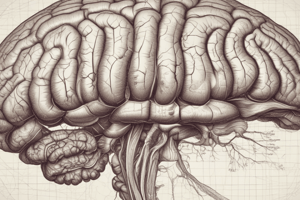Podcast
Questions and Answers
Which axons are the only ones to leave the cortex to medulla in the cerebellum?
Which axons are the only ones to leave the cortex to medulla in the cerebellum?
- Axons of red nucleus
- Axons of Purkinje cells (correct)
- Axons of deep cerebellar nuclei
- Axons of vestibular nuclei
What is the primary destination of the main efferent fibers from the cerebellum?
What is the primary destination of the main efferent fibers from the cerebellum?
- Vestibular nuclei and red nucleus (correct)
- Deep cerebellar nuclei and cortex
- Ventral lateral nucleus of thalamus and cortex
- Spinal cord and peripheral nervous system
Which zone of the cerebellum is concerned with the planning of sequential movements of the entire body?
Which zone of the cerebellum is concerned with the planning of sequential movements of the entire body?
- Vermis
- Lateral zone (correct)
- Intermediate zone
- Deep cerebellar nuclei
What is the clinical implication of a cerebellar lesion on muscle tone?
What is the clinical implication of a cerebellar lesion on muscle tone?
Which of the following is a characteristic of a patient with a cerebellar lesion during gait?
Which of the following is a characteristic of a patient with a cerebellar lesion during gait?
What is the term for the disturbance of reflexes in a patient with a cerebellar lesion?
What is the term for the disturbance of reflexes in a patient with a cerebellar lesion?
Which test is used to assess dysdiadochokinesia in a patient with a cerebellar lesion?
Which test is used to assess dysdiadochokinesia in a patient with a cerebellar lesion?
What is the main function of the intermediate zone of the cerebellum?
What is the main function of the intermediate zone of the cerebellum?
Which nuclei are the primary origin of the efferent fibers from the cerebellum?
Which nuclei are the primary origin of the efferent fibers from the cerebellum?
What is the characteristic of the patient's posture in a cerebellar lesion?
What is the characteristic of the patient's posture in a cerebellar lesion?
Flashcards are hidden until you start studying
Study Notes
Cerebellum Structure and Connections
- Originated from the hindbrain, separated from pons and medulla by the fourth ventricle
- Connected to the brain stem by inferior, middle, and superior cerebellar peduncles
External Features
- Consists of two cerebellar hemispheres joined in midline by the vermis
- Surface is highly convoluted, forming folia separated by fissures
Anatomical Subdivisions
- Anterior lobe: lies above the V-shaped primary fissure
- Posterior (middle) lobe: between primary fissure and uvulonodular fissure
- Flocculonodular lobe: posterior to uvulonodular fissure
- Superior and inferior surfaces: separated by a horizontal fissure
Constituents
- Outer grey matter: cerebellar cortex
- Inner white matter: cerebellar medulla has 4 masses of grey matter embedded in it
Cerebellar Cortex
- Divided into 3 layers:
- Molecular layer: stellate cells, basket cells, scattered between branches of nerve cells
- Purkinje cell layer: large golgi type 1 neurons
- Granular layer: granule cells, golgi type II neurons
Cerebellar Nuclei
- Four masses of grey matter:
- Dentate nucleus
- Emboliform nucleus
- Globose nucleus
- Fastigial nucleus
Fibers in White Matter
- 3 types:
- Intrinsic fibers
- Afferent fibers
- Efferent fibers
Afferent Fibers
- Corticopontocerebellar: from frontal, parietal, temporal, and occipital lobes
- Cerebroolivocerebellar: from inferior olivary nuclei
- Cerebroreticulocerebellar: from sensorimotor areas
- From spinal cord: anterior spinocerebellar and posterior spinocerebellar
Cerebellar Medulla
- Axons of Purkinje cells are the only axons to leave the cortex
- Most axons do not leave the cerebellum and end in deep cerebellar nuclei
- Efferent fibers mainly go to vestibular nuclei, red nucleus, and ventral lateral nucleus of thalamus
Functional Subdivisions of the Cerebellum
- Cortex of vermis influences movements of long axis of body
- Intermediate zone controls muscles of distal parts of limbs
- Lateral zone involved with planning of sequential movements and conscious assessment of movement errors
Clinical Implications
- Hypotonia: postural changes and alteration of gait
- Ataxia: tremors, decomposition of movements, and disturbance of reflexes
- Clinical manifestations: wide base when standing, staggering, and pendular knee jerk
Studying That Suits You
Use AI to generate personalized quizzes and flashcards to suit your learning preferences.



